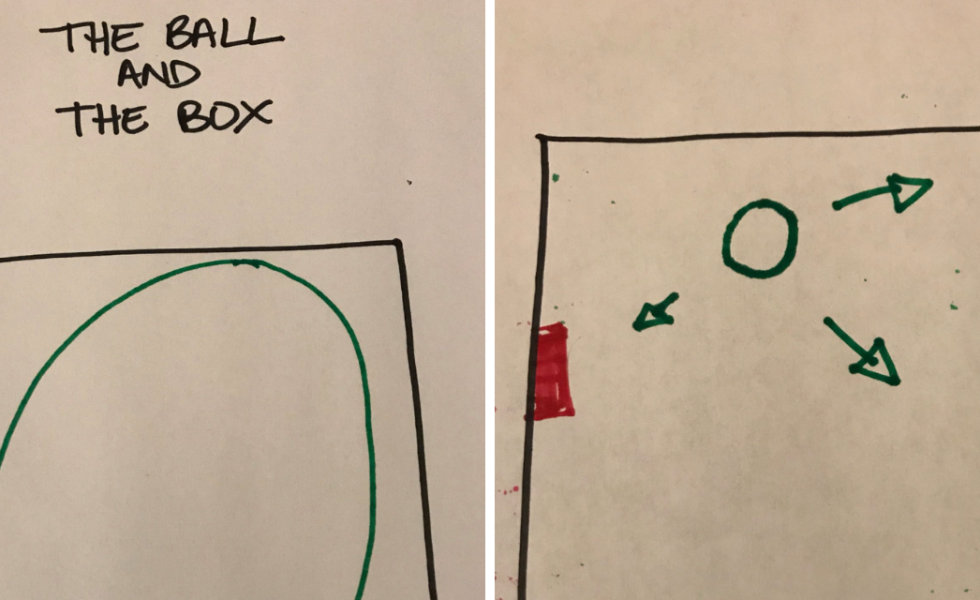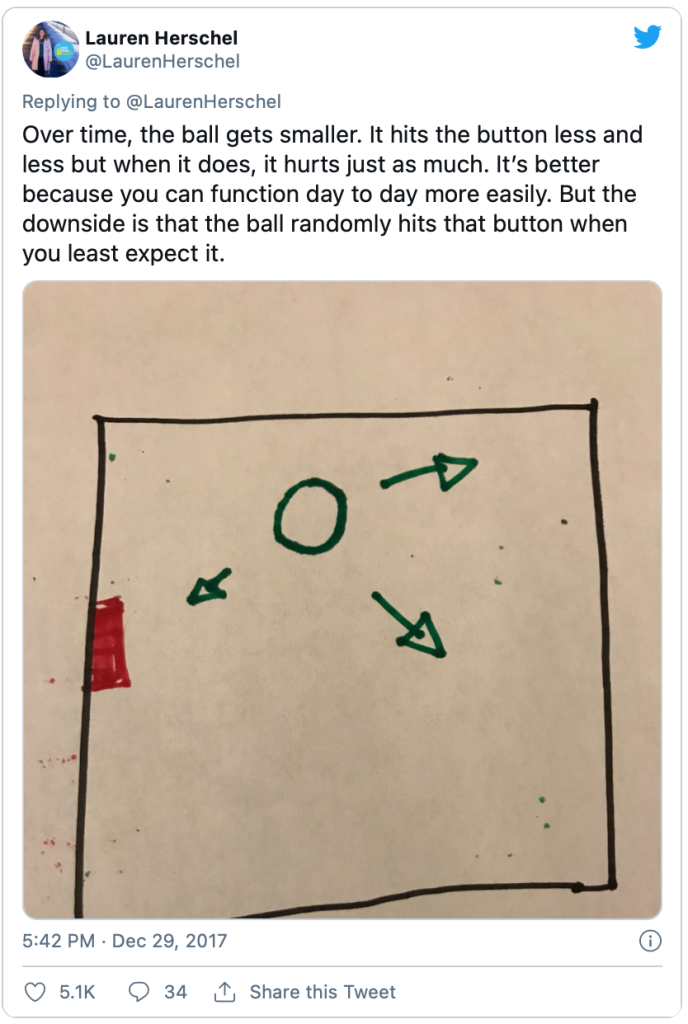Grief Is Like… The Ball and the Box

This is the second post in a short series on analogies of grief. You can read the first post here, which includes an introduction to the importance of these analogies.
A couple of weeks ago I was talking to a friend about his experience of grief over the loss of his mom not long after another anniversary of her death. It has been years since her death but the pain of her absence remains and has morphed in some ways as he has grieved. I asked him if he thinks the grief at each anniversary and personal remembrance will dissipate over time and how he feels about that happening. Because for many of us, there’s both a good that comes in “moving on” and another layer of grief (and potentially guilt and shame) for doing so. “Moving on” means healing and growth. It can be the result of grieving well, where the lost loved one is still remembered and cherished but the agony of grief has subsided for the one who remains. However, it can still feel bad. It can feel like you’re abandoning or forgetting them.
My friend replied along these lines. And then he shared this analogy of grief with me: “The Ball and the Box.” Several years ago this analogy went somewhat viral through a series of tweets (you can read about it here). It seems like this is a somewhat common analogy shared by counselors and other mental health professionals with those for whom they care. I think it helpfully describes the experience of grief as time goes on and how to make sense of the times we seem to have been randomly “triggered” into fresh sadness.
Analogy of Grief: The Ball in the Box
So how does this analogy work? Imagine there is a box with a button on one side of the wall like the picture below. When your experience of loss and grief is fresh, the ball is big! It seems to fill the whole space of the box. It bounces around the box like the old “DVD Video” logo (immortalized in this hilarious scene from The Office). When the button is hit by the ball, grief and sadness is activated. Since the ball is gigantic, this happens A LOT and you feel out of control as waves of sadness unrelentingly beat you down. It can feel unending and debilitating.
However, as Lauren Herschel mentions in her original tweets, over time and with help in the grieving process, the ball gets smaller and “hits the button” less often. However, sometimes it still does — just like the “DVD Video” logo eventually bounces exactly into the corner of the screen (again, you have to watch this scene). This helps us make sense of those moments of seemingly random grief that occur years and years after an event or the loss of a loved one. For Herschel it was the sight of a woman at the store who resembled her grandmother, which activated her grief about her mother. For me, it was the thought of showing my wife and kids around my grandparents’ house that made the sorrow for my deceased grandfather surge up within me. Or simply walking into the lobby of the hospital where my daughter was admitted for weeks after her birth (she’s happy and healthy now). What is it for you?
Grieving With Hope
Grief is a perplexing experience. It continues to be so even as time extends past the event of loss, pain, or suffering. It can linger because of continued, chronic pain and suffering. It can surprise us as a sudden emotional ambush. This is in part because God has made us as body-soul amalgams with a rich emotional life (though this can be suppressed and stunted). It is also in part because we have loved much. Our grief can show our love, affection, and attachment. It is in part because the world is sin-sick and deeply broken. Our grief can evidence an impulse to lament wrongdoing and brokenness. These flow from good places. Thus, grief can even feel good at times — a right response to sad, broken things.
Analogies like this one can be helpful in making sense of our experience. And yet, those who trust in Christ can have even more good encouragement that the experience of grief will dissipate and that it is not meaningless or without resolution. In 1 Thessalonians 4, the Apostle Paul, starting in verse 13, answers the local congregation’s concerns about their deceased Christian brothers and sisters. Where are they? What has happened to them? And, how should they grieve?
Paul answers them, but first indicates that he gives his answer to them so that they “may not grieve as others do who have no hope” (4:13). With that as his purpose, he goes on to encourage them with the implications of Christ’s Resurrection as it pertains to those who have died “in the Lord.” Blessedly, these lost loved ones, along with the Thessalonians themselves, “will always be with the Lord” (4:17) — whether in spirit or bodily after Christ returns. Jesus brings resurrection for all of His people through His own. Because of this, they could have hope in all of their grief — even as it stretched out over the years and would be frequently reactivated in the patterns of daily living. They could “encourage one another with these words” over and over again (4:18).
We too can find comfort here. We too can encourage each other with these words. Even when the ball in our box is large and regularly activating our grief. Even when the ball has shrunk over time and yet reactivates our grief again and again. We can have hope. We can grief with hope. Things will not always be this way! Eventually, all tears will be wiped away (Rev. 21:4). Eventually, our experience of the eternal weight of God’s glory will surpass the suffering of this world in our experience (2 Cor. 4:17-18). Eventually, there will be no more ball or button in our box. In the meantime, we have in Jesus a Friend who will never fail us and consolation in the community of His Church. This is good news as we look forward, but it is also good news for us now as we continue to make sense of the ball in our box.

